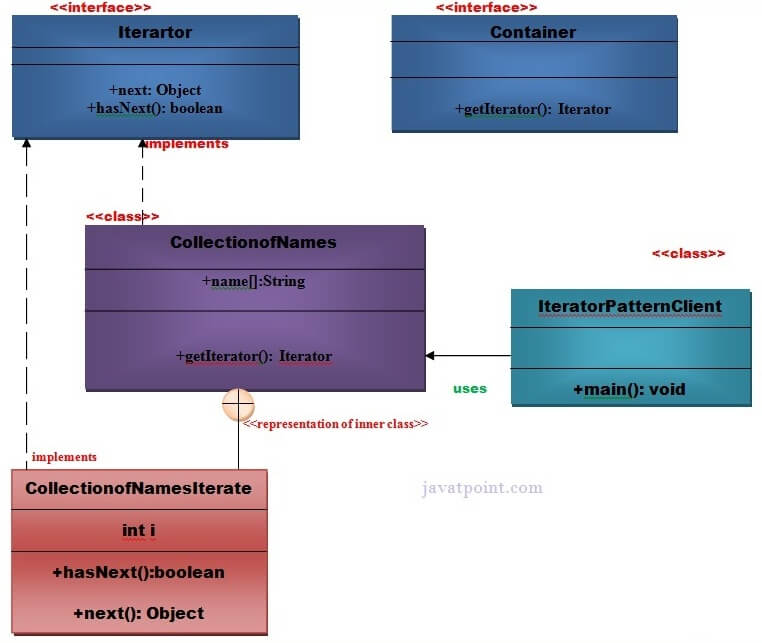Iterator Pattern
Iterator Pattern
According to GoF, Iterator Pattern is used “to access the elements of an aggregate object sequentially without exposing its underlying implementation”.
The Iterator pattern is also known as Cursor.
In collection framework, we are now using Iterator that is preferred over Enumeration.
Advantage of Iterator Pattern
- It supports variations in the traversal of a collection.
- It simplifies the interface to the collection.
Usage of Iterator Pattern:
It is used:
- When you want to access a collection of objects without exposing its internal representation.
- When there are multiple traversals of objects need to be supported in the collection.
Example of Iterator Pattern
Let’s understand the example of iterator pattern pattern by the above UML diagram.
UML for Iterator Pattern:

Implementation of above UML
Step 1
Create a Iterartor interface.
public interface Iterator {
public boolean hasNext();
public Object next();
}
Step 2
Create a Container interface.
public interface Container {
public Iterator getIterator();
}// End of the Iterator interface.
Step 3
Create a CollectionofNames class that will implement Container interface.
public class CollectionofNames implements Container {
public String name[]={“Ashwani Rajput”, “Soono Jaiswal”,“Rishi Kumar”,“Rahul Mehta”,“Hemant Mishra”};
@Override
public Iterator getIterator() {
return new CollectionofNamesIterate() ;
}
private class CollectionofNamesIterate implements Iterator{
int i;
@Override
public boolean hasNext() {
if (i<name.length){
return true;
}
return false;
}
@Override
public Object next() {
if(this.hasNext()){
return name[i++];
}
return null;
}
}
}
}
Step 4
Create a IteratorPatternDemo class.
public class IteratorPatternDemo {
publicstaticvoidmain(String[] args) {
CollectionofNames cmpnyRepository = new CollectionofNames();
for (Iterator iter = cmpnyRepository.getIterator(); iter.hasNext();) {
Stringname = (String) iter.next();
System.out.println(“Name : ” + name);
}
}
}
OUTPUT:
Name : Ashwani Rajput
Name : Soono Jaiswal
Name : Rishi Kumar
Name : Rahul Mehta
Name : Hemant Mishra